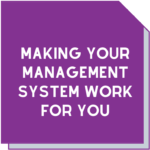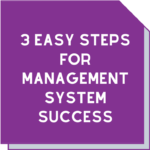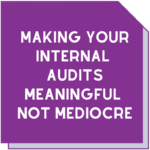Supercharge your systems!
 Many organisations have a quality (or environment, or safety) management system. If you’re in one of these organisations, then I bet you’ve sometimes felt like the ‘system’ rules your life, rather than you ruling the system.
Many organisations have a quality (or environment, or safety) management system. If you’re in one of these organisations, then I bet you’ve sometimes felt like the ‘system’ rules your life, rather than you ruling the system.
How did it get to be this way? More importantly, how can you change this?
It probably got to this point because systems auditors have made numerous, well-meaning suggestions (or demands) over the years. And you’ve thought to yourself, “I’ll just go along with these suggestions or demands to make my life easier”.
Now you need to take stock and simplify plus learn to critically analyse feedback from auditors.
Where do I start?
If you’re going to go through the task of refining your systems, then it’s always a good thing to start at the top, with a hard reflection of your vision and mission.
Why does your business exist? What is the business is striving to achieve? What is the market for your products or services?
It’s important to write these down, even if you’re a one-person band. It will create some clarity for the tasks that follow.
If you did this exercise years ago but haven’t thought about them since you started, now is the time to revisit your vision and mission. A lot has changed between then and now.
Not only does this make good business sense, but it’s also something which management system standards are including as requirements. Get your beverage of choice and start once you’ve finished reading this article! If you’re part of a bigger organisation and others are responsible for this, make it your business to find out this information – beverages are optional.
Now have a clear idea of where the business is heading, what next?
Good objectives can be your friend
 Think about your objectives for quality, or safety or environmental processes within your organisation. Make these objectives SMART (simple, measurable, attainable, relevant, and time-bound). Importantly, make sure that they are related to your vision and mission.
Think about your objectives for quality, or safety or environmental processes within your organisation. Make these objectives SMART (simple, measurable, attainable, relevant, and time-bound). Importantly, make sure that they are related to your vision and mission.
If your vision is to provide a high-quality testing service, then good objectives would be set around achieving low (but not zero) numbers of non-conformances from QC used in testing processes and a small number of statistical outliers from external quality assurance activities.
Let your staff know what your objectives are. After all, they’re ones helping achieve your goals. Put your objectives up on the wall for all your staff to see and reward them when the objectives are met.
Now what?
The last step is to review your current systems.
Do they help you to achieve your objectives? This task can be bigger than you think, so it’s a good idea to break down the various aspects of your system.
If your objective is to do with your QC outcomes, look at the agility of your system for capturing, reviewing, and acting on QC results. Can it be automated? What system do you have for setting action and warning limits? Integration is the key here. One process serving multiple functions lifts efficiency and effectiveness. Be brave and take control!
‘Helpful’ auditor suggestions
You know how it is. You’re in the cut and thrust of an audit by an external auditor. The auditor makes an observation that you could do things more efficiently. You may not have even been in the room when the suggestion was made. Hey presto, a condition appears in your report to do X to your form or processes to ensure compliance with ‘the requirements’. At the end of the audit you’re just too exhausted to argue and gratefully accept this helpful ‘suggestion’.
To make life easy you change your system to keep the auditor happy. Your staff may grumble but you explain it’s what the auditor wants. Over the years, more and more of these ‘helpful’ suggestions are implemented but now the system doesn’t hang together. You’re trapped in a system that is unwieldy and you and your staff feel like slaves to it.
We’re not advocating for no system to be in place. Systems are great because they help fallible humans (like us) to perform tasks correctly when we’re tired, sick or busy. But writing the same information multiple times in a certain spot, just to keep an auditor happy makes no sense at all.
Managing your audit
 You’re almost ready for your audit. But you still need to be prepared.
You’re almost ready for your audit. But you still need to be prepared.
First and foremost, know the requirements! Dig them out or download a copy, go to the section on the topic of interest and meaningfully read what the clauses are stating. It is very rare for a requirement to state that you should record a piece of data in a particular way (save for test methods, which often give information on significant figures and supporting information to be recorded).
Get your staff to know the requirements too. You don’t need to be able to repeat them to an auditor verbatim – leave that task to an auditor’s trivia night – but you should at least have a reasonable idea whether there are any requirements on the topic, and a general understanding of the types of things required. Ideally you and your staff should do this just before the audit so that it is fresh in your memory.
Next, know what you want to get out of your system. Your quality objectives are a great starting point. These can provide the clarity you need to decide what’s important, what you want to achieve.
Ask yourself, “Is my current system allowing me to realise these objectives?” If it is, then think hard whether you really need to change the system then advocate that position to the auditor.
Perhaps the auditor did not fully appreciate how your system fits together. Perhaps the auditor did not understand what you are trying to achieve. Or perhaps the auditor hasn’t been exposed to “your way of doing things” and was used to seeing things done a certain way. Use your quality objectives and your knowledge of the requirements and system to your tactical advantage.
A different perspective
The other alternative is that the auditor could, in fact, be correct. Perhaps the system isn’t as efficient as it could be. The auditor might have missed the mark on what should be changed, but she might have been onto something.
Take the fact that someone outside your organisation has observed your systems with a fresh set of eyes and noted inefficiencies of some type. Use this as a prompt to critically evaluate your system through unbiased eyes and ask the big, brave question, “Am I a slave to the system and can things change?”
If you’re not sure where to start with critically evaluating auditors’ feedback, want help in understanding the criteria against which you are being audited, or just know things are not working with your system, we can help.
We’ve had lots of experience with taming the savage systems beast and teaching people on how to deal with auditor feedback.
Contact us by emailing info@masmanagementsystems.com.au or call Maree on 0411 540 709.
Remember you don’t have to do this alone!
Download the article Supercharge your systems






